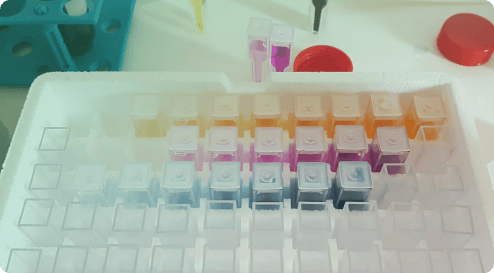


ScanSpectrum is a portable VIS-NIR spectrometer, enabling in-situ agricultural and environmental analysis at scale. It is both affordable and performant, constructed through years of testing and design by the hardware and software engineers at QED.
The need for information
Why ScanSpectrum
ScanSpectrum was inspired by the scarcity of publicly available agricultural and medical data, especially in Sub-Saharan Africa.
The pain points we address are:
- the high prices of benchtop lab instruments for compositional assessment, and
- the logistical costs of ferrying samples from field to lab.

To translate data into actionable and practical policies, collecting larger and more spatially distributed datasets with “good enough” sensors is often more effective than having only a few expensive sensors at limited sentinel sites. ScanSpectrum provides a pragmatic method of both collecting training data at scale, and deploying calibrated models in the field and across supply chains.
How we do it
Our Approach
ScanSpectrum is being used by a network of researchers and first-class laboratories in several countries to detect a multitude of phenomena, including crop and plant nutrition, plant stresses, and food integrity. Together we are building a battery of scientific evidence demonstrating what is possible with this portable and affordable device. If you wish to join our network, please reach out. We also promote a hybrid approach that switches between dry and wet chemistry, depending on what is being assessed, as our device supports both reflectance spectroscopy for solids, and transmittance spectroscopy with liquid analytes placed into an insertable standard-issue cuvette. Our technology can be reshaped into a variety of different form factors, such as handheld scanners for in-field manual assessment, or ruggedized modules for automated assembly lines.

The device for all environments
Portable and Accessible
Our current in-field sensor is shaped like a Star Trek phaser, and carried in a compact, fitted case complete with documentation, accessories, and spare parts. It interfaces seamlessly with an Android phone via USB port and provided cable, and it reports both the spectrum and NDVI in seconds, while also saving the georeferenced data, in openly accessible formats. Sample preparation procedures differ depending on targets, but can be automated with custom design.


We are interested in partnering with organizations aiming to solve specific industrial use cases with spectroscopy, and manufacturing partners or philanthropists to scale up production.

Characteristics

Portable
ScanSpectrum is ultra-lightweight and fits in the palm of your hand. It plugs into your own Android phone and power bank. Everything you need comes in a compact suitcase that fits in your backpack.

Fast
Scan specimens in seconds. Lighting fast data capture with immediate rendering of spectrograms onto your phone.

Adaptable
Choose how you want to play. Configure different muzzles and plug-ins to support both colorimetric wet chemistry and infrared spectroscopy.

Interoperable
Spectra are recorded in open, machine-readable formats. Share and build models to your heart’s content. Tie spectra and questionnaires together via a direct integration with Open Data Kit (ODK).

Reliable
Compute concentrations with accuracies identical to lab equipment costing hundreds of times more.

Affordable
We channel the strongest techniques from the maker movement, including 3D printing and ARM technologies, to build professional hardware at affordable costs.
Use Cases
Plant Health Assessment
Capture NDVI, nitrogen concentration, moisture, and other vegetation indexes in seconds. Perform the same measurements done by crop sensors and chlorophyll meters, as evidenced from years of experimental trials.

Environmental Health
Rapidly measure water quality metrics such as acidity and chemical oxygen demand. Assess the completion of chemical reactions in industrial settings.

Soil Analysis
Use colorimetry and transmittance mode to measure labile nutrients such as C, N, P, K. Or use reflectance mode to build localized predictive models for C, N, and pH.

Specifications
| Spectral range | 400-1000 nm |
|---|---|
| Resolution (FWHM) | 3 nm |
| Measurement time | 4s |
| Spectral image size | 1920 px |
| Working modes | reflectance mode, including special mounts for leaves and powders; transmittance mode, using standard cuvettes |
| Weight (full kit) | 860 g |
| Dimensions (case) | 27.5 x 24 x 7.5 cm |
| Operating temperature | 0-70°C |
| Power requirements | 5V, 2A USB source |
| Integrations | Open Data Kit (ODK) |


Become our partner
To begin discussing opportunities for partnership, click the button below!




